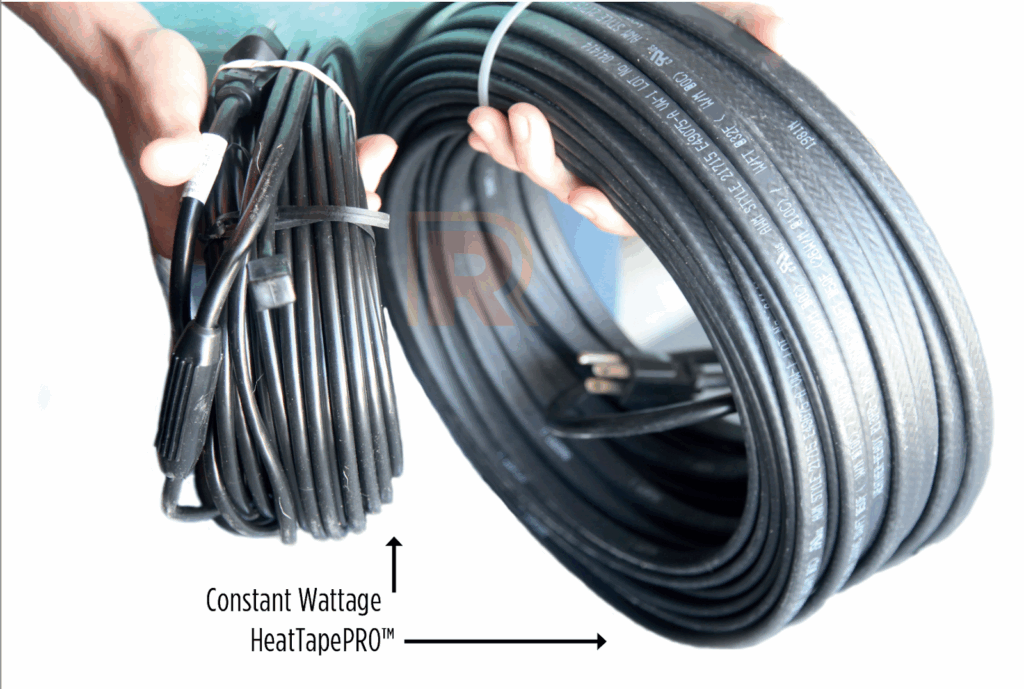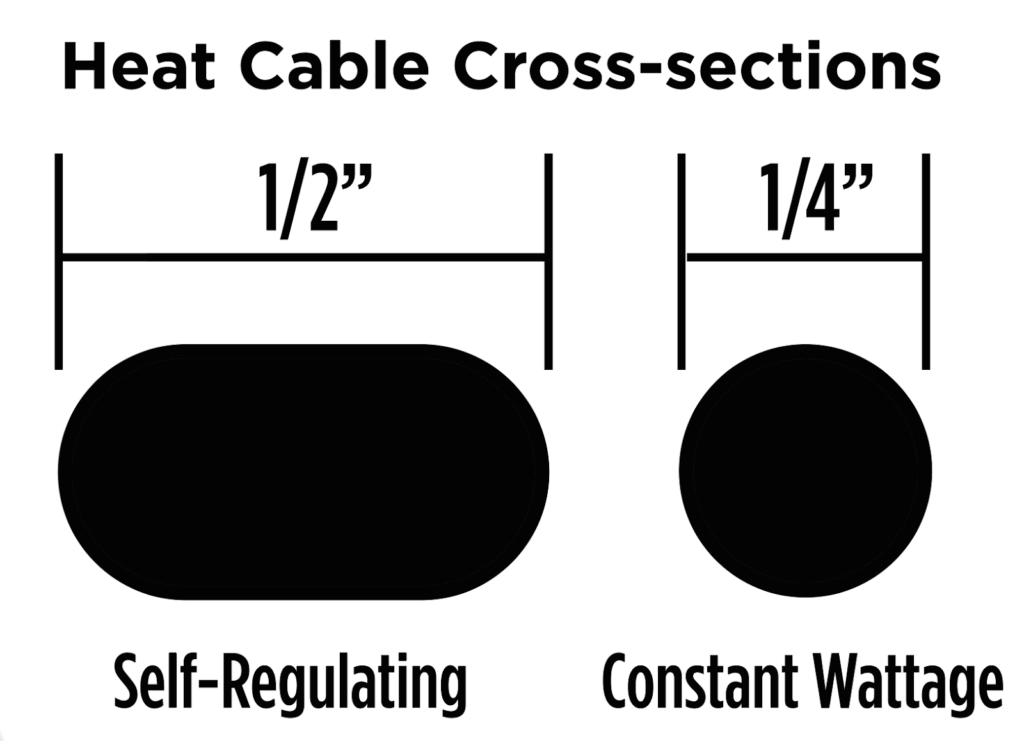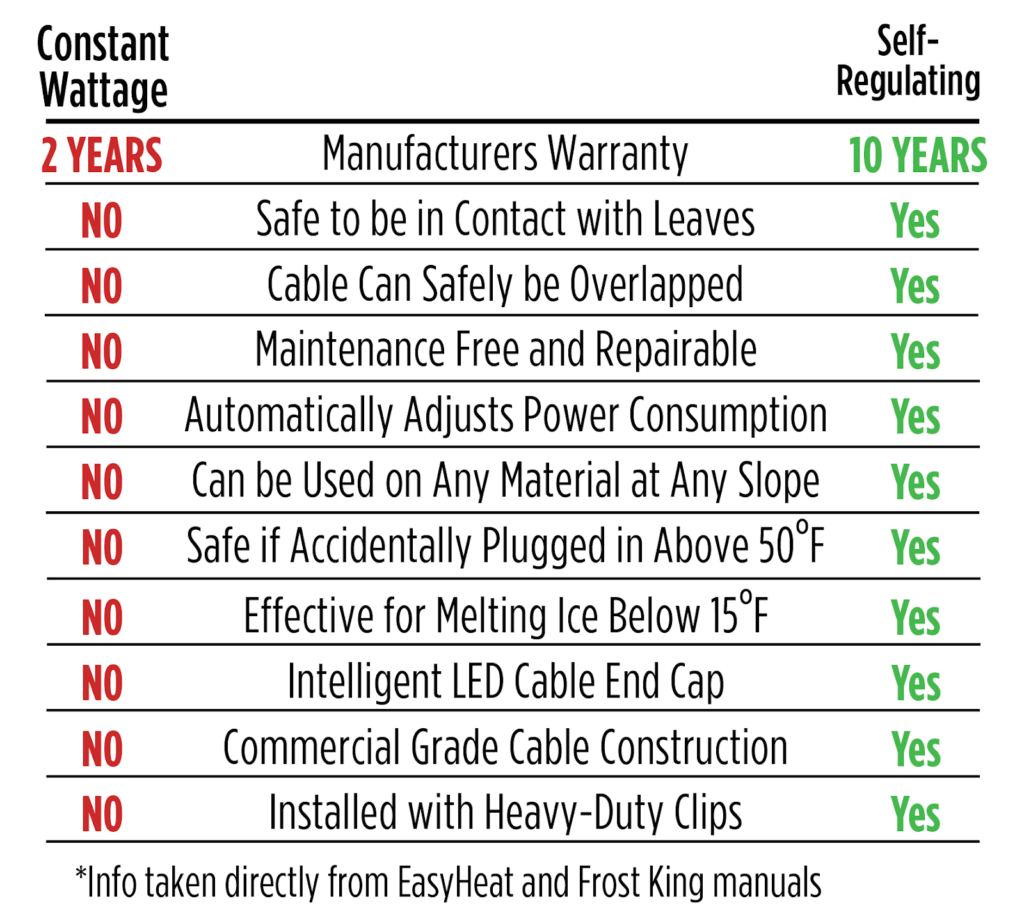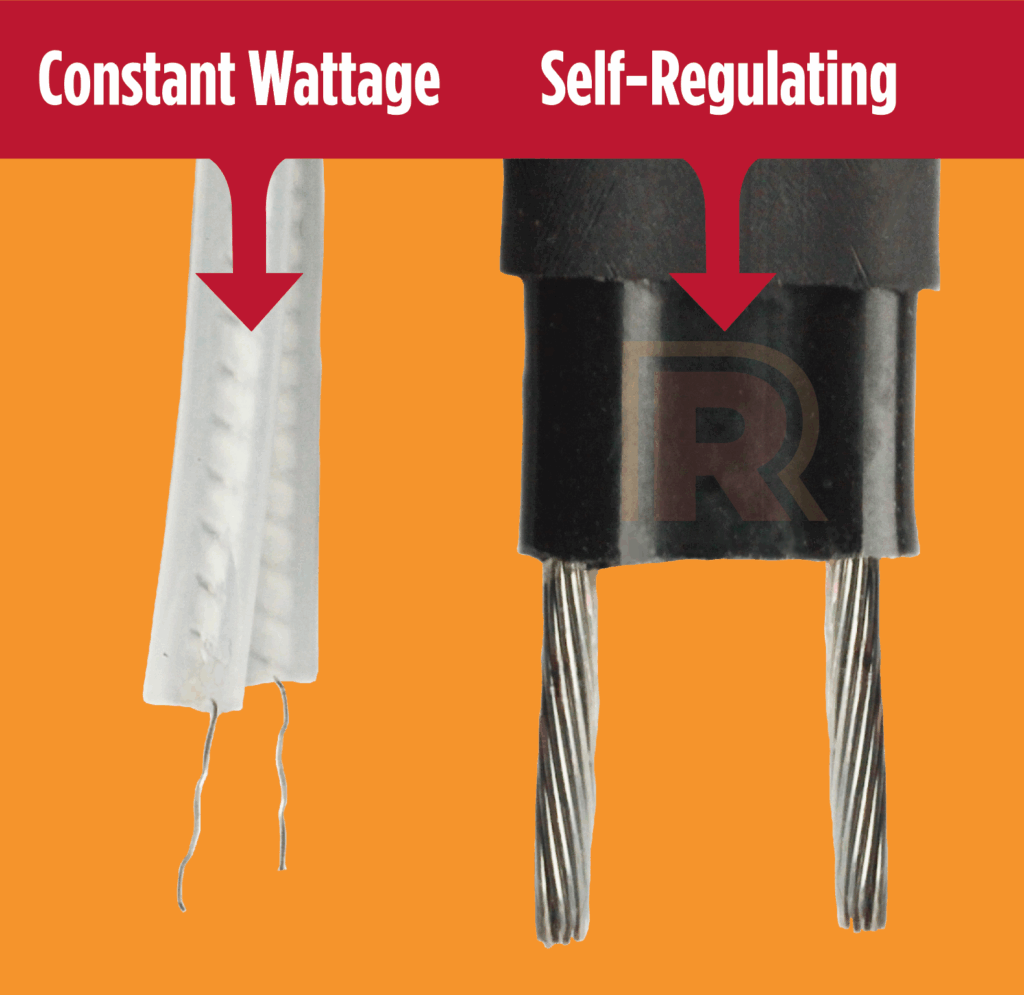Comparing Constant Wattage and Self-Regulating Heat Cable

When choosing heat cable for ice dam prevention or pipe freeze protection, you’re looking at two fundamentally different technologies: constant wattage and self-regulating heat cable. While constant wattage cable costs less upfront—often running at 1/3 or 1/4 the price—there’s a reason professional installers vigorously avoid it. Self-regulating heat cable offers superior safety, durability, and long-term value, with industry experts reporting that roughly 60% of heat tape replacements involve tearing out failed constant wattage systems.
What is Constant Wattage Heat Cable?
Constant wattage cable gets its name from the fact that—unlike self-regulating cable—it does not automatically adjust its energy consumption with changes in outdoor temperatures. It is hot, hot, hot, 100% of the time when plugged in. Unfortunately, constant wattage heat cable is the most widely used roof deicing cable in the country, accounting for roughly 90% of all residential installations and nearly 100% of all complaints, including failures and fires. The primary reason people choose constant wattage is that it is cheap.
How to Identify Constant Wattage Heat Cable

Identifying constant wattage cable visually is easy. It’s round and black (or grey) in color, with a cross-section measuring about a 1/4 inch in diameter. It is usually sold under the brand names of Frost King, EasyHeat, Wrap-On, Heat-It, or Prime Wire. Constant wattage cables are typically the only option at local hardware stores and big-box retailers like Home Depot and Lowe’s. In contrast, self-regulating cable has a larger cross-section, measuring about 1/2 inch.
What is Self-Regulating Heat Cable?
Self-regulating heat cable represents a smarter approach to freeze protection. This technology features a semiconductive heating core between two copper bus wires that automatically changes resistance with temperature. As temperatures drop, the core becomes more conductive and the cable produces more heat. When it warms up, the core resists current flow and reduces output. This “smart” behavior makes self-regulating cable inherently safer and more energy-efficient than constant wattage systems.
Why Do Professionals Avoid Constant Wattage Heat Cable?
Short Lifespan and High Failure Rate
Constant wattage cables typically carry only 1-2 year warranties and are prone to failing after just a few years of use. Industry experts report that many constant-watt installations must be replaced quickly—one inspector notes that roughly 60% of his “heat tape” replacements involve tearing out constant-watt cable, and roofing contractors report that about 50% of their jobs involve removing cheap EasyHeat or Frost King tape (both constant-watt brands).
Poor Construction and Reliability
Low-cost constant cables use very fine resistive wires and usually rely on crimped or press-fit connections (not soldered) between the heating element and bus wires. These tiny wires and loose connections often break or develop cold spots under stress, leading to sections of cable that no longer heat. By comparison, self-regulating cable uses thicker copper bus wires (typically 16 AWG nickel-plated copper) and a solid polymer core designed for heavy-duty use.
Safety Hazards
Because constant wattage tape is always on at full power, it cannot overlap, touch itself, or lie against combustibles. If it does, it can overheat, burn out, or even ignite nearby debris. The industry warns that leaves, pine needles, or other debris must be cleared away from the constant cable to prevent fire. In practice, misuse of constant cable has led to burnouts and unsafe conditions, so many professionals refuse to install it, preferring the inherently safer self-regulating type that never overheats.
False Economy
The only real advantage of constant wattage tape is its low upfront price. Experts emphasize that this cheap cost is short-lived: constant cable’s short life and higher energy use make it more expensive over time. Many professionals advise homeowners that paying more initially for self-regulating cable will avoid early failures, repeated replacements, and safety risks down the road.
Comprehensive Feature Comparison

| Feature | Constant Wattage Heat Cable | Self-Regulating Heat Cable |
| Heat Output | Fixed output, always at 100% power | Adjusts output with temperature |
| Overlap Safety | Cannot overlap; overheating risk | Safe to overlap, no overheating |
| Debris Safety | Must be cleared of leaves/needles | Safe with leaves/pine needles |
| Temperature Effectiveness | Only effective above 15°F | Effective down to –20°F or lower |
| Roof Compatibility | Not allowed on metal, wood, slate, rubber, flat roofs | Works on all roof types |
| Warranty | 1–2 years | 10 years |
| Lifespan | Often fails within 5 years | 10–20+ years |
| Construction | Thin resistive wires, fragile insulation | Thick copper bus wires, heavy-duty insulation |
| Energy Efficiency | Always draws full power | Uses only necessary power, energy efficient |
| Retail Availability | Widely sold at big-box stores (Frost King, EasyHeat, Wrap-On) | Specialty/commercial supply, not sold at big-box |
Cable Construction Differences

The difference in construction quality between constant wattage and self-regulating heat cables is obvious when looking at the internal components. The conductor ‘main’ wires inside heat cables do the heavy lifting. When conductors fail, so does the cable.
Inside a constant wattage cable, the conductors are tiny. Breakage of these tiny conductors is a common source of failure.
Self-regulating heat cable was originally engineered for heavy-duty applications (like wrapping fuel oil railcars) and is designed to withstand harsh environmental conditions, including extreme temperatures and moisture. Its main conductors are thick and can take heavy lifting. The robust inner insulation layer and outer protective jacket provide excellent mechanical strength, UV resistance, and abrasion resistance, ensuring long-term reliability and durability.
Roof Compatibility Differences
Self-regulating cable works on any roofing material or slope—asphalt, metal, rubber, wood, slate, TPO, and more. By contrast, constant watt tape is explicitly not allowed on most roofing materials: it cannot be used on metal roofs, many flat or rubber roofs, wood roofs, slate, tile, or roofs with gutter guards. It also cannot touch metal flashings or gutters unless those are separately grounded.
Temperature Performance
Self-regulating cables perform down to very low temperatures (often rated to -20°F) because they boost output in the cold. Constant watt cables, however, are only effective when it’s relatively warm—usually above about 15°F. Using a constant cable below its threshold can actually worsen ice dam problems.
Energy Efficiency and Operating Costs
Because it only draws full power when needed, the self-regulating cable is much more energy-efficient. It reduces current flow as surfaces warm, saving electricity over the winter. Constant watt cable, by contrast, runs at full power whenever on, so even if its instantaneous draw is lower, it runs longer and wastes energy.
Studies show that self-regulating systems draw power only where and when needed (for example, sections under snow or ice), whereas constant cable wastes energy running even when no heat is required.
Is Self-Regulating Heat Cable Worth the Higher Cost?
Yes. Although quality self-regulating cable costs more upfront (often 2-3× the price per foot of cheap constant tape), experts agree the extra investment pays off in the long run:
Total Cost of Ownership
The only advantage of cheaper constant cable is its low initial price. Over time, however, the frequent failures, replacements, and higher energy use of constant cable make it more expensive overall. Self-regulating systems may cost more at purchase but save money on repairs, replacements, and electricity over their decades of life.
Warranty and Reliability
You get a much longer warranty (often 10 years) and far fewer headaches with a self-regulating cable. This translates into lower maintenance costs and more years of trouble-free operation.
Safety and Peace of Mind
The superior safety of self-regulating cable avoids the fire risks and potential property damage associated with constant tape. For most homeowners and professionals, that peace of mind is invaluable.
Expert Recommendations
Many professionals flatly recommend self-regulating cable despite its price. Quality self-regulating cable “lasts far longer than big-box brands and is backed by better warranties,” and its lower operating costs more than justify the cost premium. Structure Tech inspectors similarly state that constant watt heat tape’s only advantage is being cheap, and that self-regulating tape is “far cheaper over the long run” once energy and lifespan are considered.
Main Benefits of Self-Regulating Heat Cable
Automatic Temperature Control
Self-regulating cable’s unique conductive core actively adjusts wattage with ambient temperature. This “smart” behavior means the cable uses only the heat needed—ramping up output in cold weather and throttling back as conditions warm. Unlike a constant tape, it never consumes 100% power continuously.
Increased Safety
Because it cannot overheat, the self-regulating cable is much safer. It can overlap itself and touch metal roofs or gutters without risk of burning out or fire. It will not ignite leaves or pine needles lying on it. There is no need to clear away debris to protect it. This safety margin is a key reason professionals prefer it.
Durability and Warranty
High-quality self-regulating cables are built for 24/7 commercial service. They carry long warranties (often 5-10 years or more) and are expected to last many winters (20+ years is not uncommon). Installers can splice and repair them in the field if cut. This makes self-regulating systems virtually maintenance-free once installed.
Versatility
Self-regulating cable can be safely cut to length, routed through complicated roof layouts, and used on any roof material. It does not require special controllers for most freeze protection jobs (though a thermostat can still be used for even finer control). This flexibility simplifies installation and operation.
Choosing the Right Heat Cable for Your Project
When selecting between constant wattage and self-regulating heat cable, consider these factors:
- Budget vs. Long-term Value: While constant wattage costs less initially, self-regulating provides better long-term value
- Installation Complexity: Self-regulating cable offers more installation flexibility
- Safety Requirements: For applications where safety is paramount, self-regulating is the clear choice
- Maintenance Preferences: Self-regulating systems require virtually no maintenance
- Energy Costs: Self-regulating cable will save money on electricity bills over time
In summary, while constant wattage heat cable’s main advantage is its low upfront cost, self-regulating heat cable offers superior safety, durability, energy efficiency, and long-term value. For professional-grade installation and true long-term reliability, self-regulating cable is widely viewed as well worth the extra investment.
Ready to protect your property with professional-grade heat cable? Contact Radiant Solutions Company at 1-877-387-4218 to discuss your specific needs and get expert recommendations for your ice dam prevention or pipe freeze protection project. Our team can help you choose the right system and connect you with qualified installers in your area.
